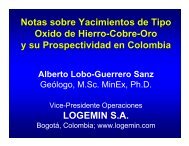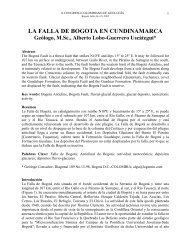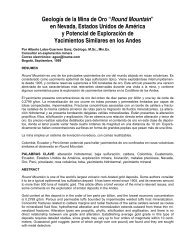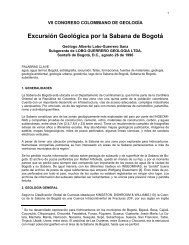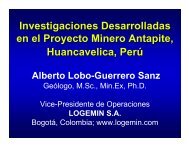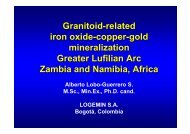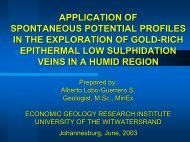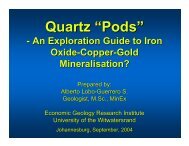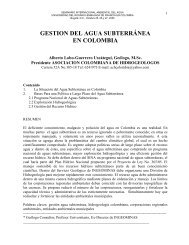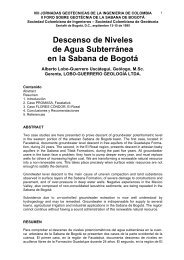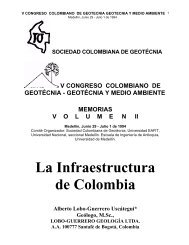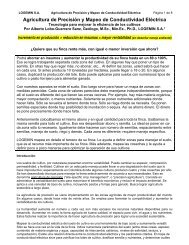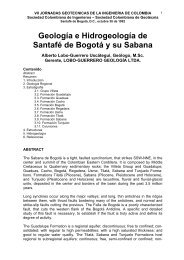“Round
'round mountain' mine
'round mountain' mine
- No tags were found...
You also want an ePaper? Increase the reach of your titles
YUMPU automatically turns print PDFs into web optimized ePapers that Google loves.
<strong>“Round</strong> Mountain”<br />
Gold Mine in Nevada, U.S.A.<br />
and Potential for Exploration<br />
of Similar Deposits in the Andes<br />
Alberto Lobo-Guerrero Sanz<br />
Consulting Geologist<br />
M.Sc.,<br />
., MinEx
INTRODUCTION<br />
• Round Mountain is one of the largest known volcanic<br />
rock-hosted gold deposits<br />
• Disseminated, epithermal low sulfidation deposit<br />
-In 1999, owned by Echo Bay Inc. (50%), Case, Pomeroy<br />
and Co., Inc. and Homestake Mining Co. (each w/ 25%).<br />
-Mined intermittently since 1905.<br />
-Reserves > 500 tons of metallic Au<br />
Visit on May 5 th , 1999, guided by Chris Ekstrom, mine<br />
geologist, who provided detailed field descriptions.<br />
Brief version of mine’s more relevant issues & comments on the<br />
exploration of similar deposits in the Andean Cordillera.
ABSTRACT 1<br />
• Permeable pyroclastics bound by impermeable<br />
rocks host mineralization + alteration.<br />
• Mineralizing fluids migrated along concentric &<br />
radial fractures related to a caldera.<br />
• Mineralization + alteration processes took<br />
ABSTRACT 2<br />
• hydrothermal alteration & mineralization spreads<br />
from thin fractures<br />
• propyllitic, phyllic, silicification and argillization<br />
• no direct relation between alteration and grade<br />
Occasional Au nuggets, sought w/ metal detector.<br />
Some weigh > 1 lb.<br />
Grade may vary up to 4 orders of magnitude in 10 cm.<br />
The mine has re-usable heap leach pads.
ABSTRACT 3<br />
Throughout the Andean Cordillera there is an<br />
important potential to find deposits confined in<br />
volcanic layers similar to those of Round<br />
Mountain.<br />
Several hundred Quaternary calderas have<br />
been detected in Colombia, Ecuador and<br />
Peru, and many of them contain precious<br />
metal disseminations.
Location Map<br />
(Oligocene – Miocene)
TOQUIMA<br />
CALDERA<br />
COMPLEX<br />
MULTIPLE<br />
CALDERAS<br />
AROUND<br />
ROUND<br />
MOUNTAIN<br />
MINE<br />
Great Basin<br />
Region,<br />
Nevada.<br />
Normal faults
CONCENTRIC<br />
CALDERAS<br />
AROUND<br />
ROUND<br />
MOUNTAIN<br />
DEPOSIT
REGIONAL GEOLOGY<br />
‘ROUND MOUNTAIN’ MINE<br />
NEVADA, U.S.A.
LITHOLOGICAL UNITS<br />
AT ‘ROUND MOUNTAIN’ MINE<br />
ROCK<br />
DESCRIPTION<br />
Type 1 Densely welded fall tuff; aquiclude. 60 m<br />
Type 9 Transitional zone to poorly welded tuff;<br />
aquiclude. 27 m<br />
Type 2 Porous, poorly welded tuff, with large<br />
pumice fragments; host rock. 100-120<br />
Type 3 Lithic-rich, dense tuff; low permeability.<br />
Base of volcanic sequence.<br />
Type 4 Paleozoic metasediments; impermeable.<br />
Basement
Type 9 Transitional zone to poorly-welded tuff, 27 m<br />
thick; eutaxitic texture due to compression, 9:1 to 2:1<br />
aspect ratio in amygdules. Transitional welding inhibited<br />
mineralizing fluid ascention and contributed to gold<br />
dissemination in rock type 2. Acted as “cap rock” or<br />
aquiclude. Rare mineralization. Hydrothermal alteration<br />
restricted to fracture walls. At first sight, it differs from<br />
other lithologies at the mine.<br />
Type 2 Porous, poorly-welded tuff, 100-120 m thick;<br />
with large pumice lapilli fragments and coarse quartz<br />
phenocrystals. It is the best host rock; acts as a sponge<br />
and received most of the Au. Intensely kaolinized and<br />
with dense normal, Basin and Range fractures.
STRUCTUAL ASPECTS (1)<br />
• important role in mineralization and aid in<br />
metal extraction<br />
• fractures served as conduits for migration<br />
of Au-rich fluids towards Type 2 porous<br />
rocks<br />
• at least 2 types of fractures<br />
1. cooling of tuffs<br />
2. caldera collapse<br />
3. late Basin and Range type (NW)
STRUCTURAL ASPECTS (2)<br />
• Preconditioned rocks for mineralization in caldera<br />
margin<br />
• Richer zones = rock suffered > fracturing<br />
• Routes of eruption and fluid conducts = intersection<br />
of<br />
-main anular fractures<br />
-radial fractures produced during system<br />
cooling<br />
Pipes or feeder tubes were emplaced in the<br />
intersections
LOCATION OF<br />
GEOLOGICAL SECTIONS<br />
DETAILED GEOLOGY<br />
ROUND MOUNTAIN MINE<br />
NEVADA, U.S.A.
ABUNDANT RADIAL<br />
FRACTURES IN THE CALDERA
A-B B vertical section controlled by drillholes,<br />
with sub-horizontal<br />
pyroclastic layers
C-D D vertical section controlled by drillholes,<br />
with sub-horizontal<br />
pyroclastic layers
MINERALIZATION (1)<br />
-electrum w/ Au:Ag ratio = 65:35<br />
-free particles & inclusions in py<br />
-generally very fine Au diss; ocasional 6.5 kg masses<br />
-Free Au in qz-adularia-py veins, also py encapsulated<br />
-traces of several Au-Ag tellurides and other sulfides<br />
-Py = dominant sulfides<br />
-Main part oxidizedan and free; electrum = free<br />
-non-oxidated. pyritic ore is refractory<br />
-Particle Au size = 30[m – 20cmØ<br />
-Gold nuggets occasional.
Typical light gray Au mineralized tuff (oxidized).<br />
Ore-grade rock does not look unusual.
Auriferous breccia.<br />
Several brecciation<br />
events.
Enlargment of<br />
silicified and mineralized<br />
portion in previous shot.<br />
Note clast-support,<br />
angularity and clast<br />
compositional variety.
Note clast packing & angularity.<br />
Free Au in this view.
Note packing degree<br />
and angular clast variety
1.9 cm Ø<br />
Vein with breccioid infill.<br />
Penny for scale.<br />
Matrix is opaline silica and contains free Au.<br />
Note clast rounding and variety.
Enlargement of previous image.<br />
Red poriton with re-brecciation and transport.<br />
Note coarse matrix, > porosity and non-oriented clasts.<br />
Compare with next.
Note evidence of flow in black<br />
ortion and orientation of angular<br />
clasts in the red portion.
Fracture intruded by Au-mineralized micro-breccia.<br />
Rounded white clasts and quartz-adularia dark gray matri<br />
with minor proportrion of py + Au.<br />
Locally called “cockscomb breccia”.
Au nuggets<br />
found in<br />
hydrothermal bxs.
Gold foil<br />
Gold nuggest<br />
found in<br />
hydrothermal bxs.<br />
Metal detectors in zones where bonanzas are expected,<br />
to recover most free Au and keep nuggets away from the<br />
leach piles.<br />
Coin 2.8 cm Ø
Nickel<br />
Nugget that weighs more than a pound.<br />
Found in vein associated with micro-breccias.
ALTERATION<br />
All the range of hydrothermal alteration from a potassic<br />
nucleus to a propylitic halo, through high level silicic<br />
alteration and intermediate argillization<br />
Alteration by hydrothermal fluids that migrate along a<br />
fracture, and away from it along permeable rocks.<br />
Disseminated py and precious metals extend 9-15 m<br />
away from main fractures.<br />
See next figure
”SANDWICH”<br />
MODEL
Panoramic view of open pit, mid summer.
Panoramic view of re-usable leach pads.<br />
Smoky Valley in background.
‘ROUND MOUNTAIN’ ECONOMIC PARAMETERS<br />
MINE RESERVES (May, 1999)<br />
RESERVES TONS (X10 3 ) gAu/ton TOTAL (tons Au)<br />
Open Pit<br />
233,638 0.6500 151.864<br />
Stock Piles<br />
127,271 0.3110<br />
39.581<br />
Indicated resources of 142 million tons not yet added to reserves.<br />
Estimated mine life: 12-15 years<br />
Milliing and leaching will ocntinue 8 years after mine<br />
-average grade: 0.7465 g Au/ton.<br />
-production costs 05’99: US$205-$210/oz (US$6.59-$6.75/gAu)<br />
-average strip ratio: 2:1<br />
-approximate open pit dimensions: 1700 x 1500 m<br />
-Open pit depth: 460 m
FINAL OBSERVATIONS<br />
• Rhyolitic tuffs (of the “ash fall” type) occur<br />
in volcanic environments that tend to be<br />
extremely explosive.<br />
• In general such rocks are porous and<br />
conform permeable layers.<br />
If they are covered by lava flows (common trait in<br />
bimodal volcanic systems) setting similar to those of<br />
Round Mountain may take place, where lava acts as<br />
an aquiclude.
ANDEAN PROSPECTS<br />
Colombia, Ecuador and Perú have a reasonable<br />
potential for gold deposits hosted in volcanic<br />
strata such as those present at Round Mountain.<br />
Several hundreds of Quaternary calderas have<br />
been detected in the Nariño deparment,<br />
Colombia, and many of them contain precious<br />
metal dissemination. Repetitive explosive activity<br />
in southern Colombian volcanic systems has<br />
exposed numerous mineralized tuffs and some<br />
welded tuffs.
Cerro Bravo Volcano, Tolima and Caldas, Colombia<br />
Dome and five concentric calderas<br />
4000 m.o.s.l., Colombian Central Cordillera
Galeras Volcano, one of the best studied in the region,<br />
expells 0.5 kg of gold per day to the atmosphere in its<br />
fumaroles, and is probably depositing more than 0.06<br />
kg Au/day in the volcanic edifice (GOFF et al [1994]).<br />
If such rates remain constant, a moderately sized gold<br />
deposit (>200 tons of contained Au) may form in only<br />
10,000 years. If an equivalent amount is left behind in<br />
porous volcanic rocks, a short lapse of hydrothermal<br />
activity may produce deposits such as Round Mountain.<br />
These observations do not take into account moments of<br />
great activity and explosive vulcanism, when fumarolic<br />
activity increases and several type of hydrothermal<br />
breccia are formed.
Nevado del Ruiz, in the axis of the Colombian Central<br />
Cordillera, is another Quaternary volcanic system<br />
studied by the author. It contains important epithermal<br />
gold dissemination associated with tuff layers limited by<br />
andesite lava aquicludes.<br />
Mineralization is conditioned to more than eight porous,<br />
permeable, pumice-rich pyroclastic layers. The system<br />
is of the high sulfidation type, since alunite conforms a<br />
large portion of the matrix in breccias and mineralized<br />
tuffs.
ECUADOR, LATERAL EXPLOSIONS<br />
Ecuador has numerous recent volcanic edifices,<br />
that are well exposed after lateral explosions.<br />
Several volcanoes in the Interandean Graben, such<br />
as Hilaló and Guagua-Pichincha are open to the<br />
west due to preferential collapse of volcanic<br />
edifices in that direction, where unidirectional wind<br />
regimes tend to erode away the ash and other<br />
components.<br />
Cerro Bravo and Nevado del Ruiz volcanoes in<br />
Colombia display clear evidence of lateral<br />
explosions.
PERUVIAN ANDES<br />
Large extensions of Eocene to Oligocene<br />
volcanic rocks outcrop in the Peruvian Andes.<br />
-older<br />
-more eroded than in the Northern Andes<br />
-may offer ideal conditions for entrapment of<br />
precious metals in Round Mountain style.<br />
Numerous high explosivity rhyolitic events,<br />
intercalated w/ pyroclastic, cineritic & welded tuff<br />
events produced monotonous sequences of<br />
porous & non-porous rocks.
Time for questions



